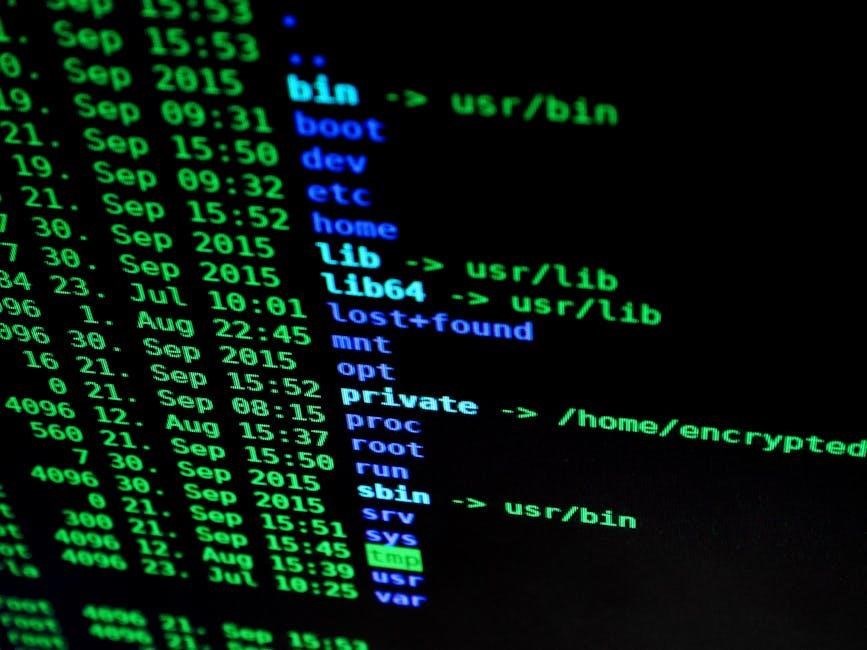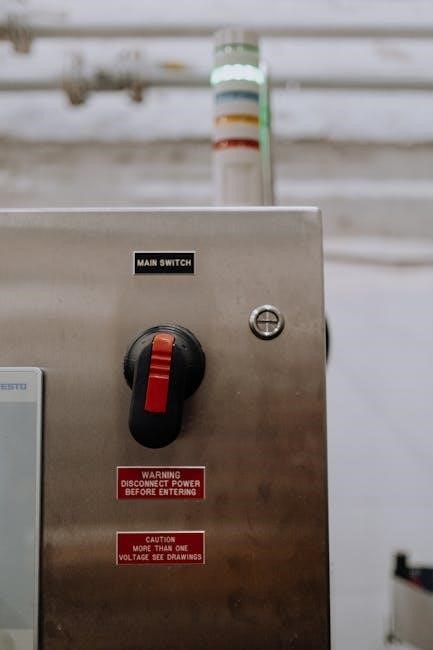
in the fda alert system the l instructs managers to
The FDA Alert System is a critical framework ensuring public safety by monitoring and responding to health risks. The L instruction guides managers to monitor operations and watch for suspicious activities, ensuring compliance and safeguarding consumers.

Overview of the FDA Alert System
The FDA Alert System is a regulatory framework monitoring safety issues related to medical products, ensuring timely notifications and coordinated actions to address risks, protecting public health and ensuring compliance.
What is the FDA Alert System?
The FDA Alert System is a regulatory framework designed to monitor and respond to safety issues related to medical products, ensuring timely notifications and coordinated actions to address risks. It incorporates clear protocols for identifying threats and triggering responses, with the L instruction guiding managers on specific actions to ensure compliance and safety. The system includes monitoring tools, notification protocols, and a database for tracking alerts, ensuring standardized processes for issuing, updating, and resolving alerts. Key components also include training materials and a feedback mechanism to improve effectiveness. The FDA Alert System is crucial for protecting public health by enabling swift action and maintaining transparency and accountability. It ensures that stakeholders are informed and equipped to respond effectively to safety issues, aligning with regulatory requirements and safeguarding consumers.
Purpose and Objectives
The primary purpose of the FDA Alert System is to ensure public health safety by enabling timely communication of risks and regulatory actions to stakeholders. Its key objectives include identifying, assessing, and addressing safety issues related to medical products, ensuring swift and coordinated responses. The system aims to standardize processes for issuing, updating, and resolving alerts, maintaining consistency across operations. It also provides a framework for managers to respond effectively, aligning with regulatory requirements and upholding public trust. By ensuring compliance and safeguarding consumers, the FDA Alert System plays a critical role in protecting public health and maintaining the integrity of the healthcare and food industries. Its objectives are achieved through clear protocols, training materials, and feedback mechanisms, ensuring continuous improvement and accountability in managing safety risks.
Key Components of the System
The FDA Alert System comprises several key components designed to ensure effective monitoring and response to safety issues. These include monitoring tools for identifying potential risks, notification protocols for disseminating critical information, and a database for tracking and managing alerts. The system also incorporates standardized procedures for issuing, updating, and resolving alerts, ensuring consistency and clarity. Additionally, it includes training materials to equip stakeholders with the necessary knowledge and skills, as well as a feedback mechanism to continuously improve the system’s effectiveness. The L instruction, part of the ALERT framework, emphasizes the importance of ongoing monitoring and vigilance in detecting suspicious activities. Together, these components create a robust framework for safeguarding public health and ensuring compliance with regulatory standards. The system’s design ensures that all elements work synergistically to address risks efficiently and maintain stakeholder trust.

The Role of the ‘L’ Instruction in the FDA Alert System
The L instruction in the FDA Alert System directs managers to monitor operations and identify suspicious activities, ensuring proactive risk management and compliance with safety standards.
Understanding the ‘L’ Instruction
The L instruction in the FDA Alert System stands for “Look,” directing managers to continuously monitor operations for potential safety risks and suspicious activities. This instruction is part of the ALERT program, which aims to prevent intentional contamination of food and drugs. By focusing on vigilance, the L instruction ensures that managers are proactive in identifying threats, such as unusual behavior or unauthorized access to sensitive areas. The instruction emphasizes the importance of ongoing surveillance and scrutiny to safeguard products and consumer health; It is a cornerstone of the FDA’s efforts to maintain security and compliance within regulated industries. Understanding the L instruction is essential for managers to implement effective safety measures and align with FDA regulations.
Significance of the ‘L’ Instruction
The L instruction holds significant importance in the FDA Alert System as it ensures proactive monitoring and vigilance in maintaining safety and security. By instructing managers to “Look” for suspicious activities, it prevents potential contamination and protects public health. This instruction is vital for identifying risks early, enabling swift action to mitigate threats. It also supports compliance with FDA regulations, ensuring that safety standards are upheld consistently. The L instruction fosters a culture of awareness and accountability, empowering managers to take decisive steps in safeguarding products and consumers. Its implementation strengthens the overall effectiveness of the FDA Alert System, making it a cornerstone of food and drug safety initiatives. By emphasizing vigilance, the L instruction plays a critical role in maintaining trust and ensuring the integrity of the supply chain.
Specific Actions Instructed by ‘L’
The L instruction in the FDA Alert System directs managers to take specific actions to ensure safety and compliance. It instructs them to monitor operations for suspicious activities, evaluate product security, and watch for potential threats. This includes assessing risks, identifying vulnerabilities, and implementing measures to prevent contamination. The L instruction also requires managers to document findings and report concerns promptly, ensuring timely responses to mitigate risks. By focusing on proactive vigilance, the L instruction ensures that managers are equipped to address safety issues effectively, aligning with FDA regulations and safeguarding public health. These actions are integral to maintaining the integrity of the FDA Alert System and upholding safety standards across operations. The L instruction is a cornerstone of the system, enabling precise and efficient execution of safety protocols.

Implementation of the ‘L’ Instruction by Managers
Managers implement the L instruction by monitoring operations, assessing risks, and ensuring compliance with FDA standards to maintain safety and regulatory adherence effectively.
Monitoring Operations for Safety
Managers are instructed to continuously monitor operations for safety under the L instruction, ensuring vigilance against potential risks and threats. This involves assessing operational processes, identifying vulnerabilities, and implementing measures to mitigate risks. By maintaining a proactive approach, managers can detect suspicious activities early, preventing intentional contamination or safety breaches. The L instruction emphasizes the importance of ongoing surveillance to safeguard products and comply with FDA regulations. This monitoring is integral to upholding safety standards and protecting public health, ensuring that all operations align with regulatory requirements and industry best practices. Regular checks and assessments are conducted to verify compliance and address any discrepancies promptly, fostering a culture of safety and accountability within the organization. This systematic approach ensures that potential threats are identified and resolved efficiently, maintaining trust and ensuring consumer safety.
Identifying and Reporting Suspicious Activities
The L instruction in the FDA Alert System directs managers to identify and report suspicious activities that could pose risks to product safety. This involves vigilance in monitoring operations for unusual behavior, unauthorized access, or potential contamination threats. Managers are trained to recognize red flags, such as unexpected changes in production processes or unexplained alterations in product appearance. Upon identifying suspicious activities, managers must document and report them promptly through designated channels, ensuring timely investigation and resolution. This proactive approach helps prevent intentional contamination and safeguards public health. The FDA Alert System emphasizes the importance of clear communication and swift action in addressing such incidents, aligning with regulatory requirements and maintaining consumer trust. By fostering a culture of vigilance, the system ensures that potential threats are mitigated effectively, upholding safety and compliance standards.
Ensuring Compliance with FDA Regulations
The L instruction in the FDA Alert System plays a crucial role in ensuring compliance with regulatory standards. Managers are guided to implement corrective actions that align with FDA rules, such as those outlined in HIPAA and FSMA. The system provides standardized protocols for addressing alerts, ensuring that all actions are documented and reported according to regulatory requirements. This includes maintaining detailed records of alert responses, corrective measures, and follow-up activities. By adhering to these guidelines, managers can ensure that their organizations remain compliant with FDA regulations, minimizing legal risks and safeguarding public health. The L instruction also emphasizes the importance of ongoing training and awareness programs to keep staff informed about regulatory updates. This proactive approach ensures that compliance is not just a one-time achievement but a continuous process integrated into daily operations.

Integration with Other FDA Processes and Systems
The FDA Alert System integrates seamlessly with other regulatory processes, ensuring alignment with food safety programs and recall efforts through the L instruction’s guidance for managers.
Alignment with Regulatory Requirements
The FDA Alert System is designed to align seamlessly with regulatory requirements, ensuring compliance with federal standards such as HIPAA and FSMA. The L instruction plays a crucial role in guiding managers to enforce these regulations effectively. By standardizing protocols for risk assessment and communication, the system ensures that all actions taken by managers are in accordance with FDA rules. This alignment not only maintains public safety but also upholds trust in regulatory processes. The integration of the L instruction into the alert system ensures that managers can respond promptly to alerts while adhering to legal and safety standards. This structured approach enables organizations to operate within the framework of regulatory expectations, ensuring consistency and accountability in all operations. The system’s ability to align with regulatory requirements makes it a cornerstone of effective alert management and public health protection.
Coordination with Recall Processes

The FDA Alert System works in tandem with recall processes to ensure swift and effective action. The L instruction plays a key role in this coordination by guiding managers to monitor operations and identify potential risks that may lead to recalls. By integrating with recall mechanisms, the system enables seamless communication and data sharing, ensuring that recalls are initiated promptly. The L instruction emphasizes the importance of timely reporting and documentation, which are critical for tracing contaminated products and minimizing public exposure. This coordination ensures that recalls are executed efficiently, reducing the risk of harm to consumers. The system’s ability to align with recall processes underscores its role in protecting public health and maintaining trust in regulatory actions. By streamlining these processes, the FDA Alert System enhances overall safety and compliance outcomes.

Challenges Faced by Managers

Managers face challenges like information overload and complex FDA regulations, requiring precise communication and quick decision-making. The L instruction adds complexity, demanding accurate implementation and timely responses to ensure compliance and safety.
Information Overload and Timely Responses
Managers often face challenges with information overload, as the FDA Alert System generates a high volume of alerts. This can lead to delays in identifying and responding to critical issues, potentially compromising safety and compliance. The L instruction, while essential for guiding actions, adds complexity by requiring precise communication and rapid decision-making. Balancing efficiency and accuracy becomes challenging, especially when managing multiple alerts simultaneously. To address this, managers must implement advanced filters and prioritize alerts based on severity. Additionally, leveraging automation tools and enhancing cross-departmental communication can streamline processes. Regular training and feedback sessions are crucial to refine response protocols, ensuring timely and effective actions that align with FDA regulations and maintain public trust. By fostering a culture of proactive problem-solving, managers can navigate these challenges more effectively.
Complexity of FDA Regulations
The FDA Alert System operates within a complex regulatory landscape, posing challenges for managers. The L instruction, while critical, adds layers of complexity by requiring precise communication and rapid decision-making. Managers must interpret regulations accurately, allocate tasks, and verify corrective actions, all while maintaining transparency and accountability. The intricate nature of FDA rules, such as HIPAA and FSMA, demands a deep understanding to ensure compliance. This complexity can overwhelm managers, especially when managing multiple alerts simultaneously. To navigate this, structured training programs and effective tools are essential. These resources help managers decipher complex regulations and execute the L instruction effectively, ensuring compliance and efficiency. By fostering a culture of proactive problem-solving and continuous improvement, managers can better manage the complexities of the FDA Alert System and maintain regulatory standards. Regular updates and feedback mechanisms further support their ability to adapt to evolving requirements.

Future Directions and Enhancements
The FDA Alert System will integrate advanced technologies like AI-driven analytics and real-time data processing to enhance efficiency and global compliance, ensuring faster responses and improved public safety.
Technological Advancements
Technological advancements are poised to significantly enhance the FDA Alert System, improving efficiency and compliance. The integration of AI-driven analytics and real-time data processing will enable faster and more accurate alert dissemination. Mobile accessibility features are expected to allow managers to receive and act on alerts seamlessly, reducing response times. Automation tools will streamline communication and documentation, ensuring accountability. These innovations will also improve data management, enabling better tracking and resolution of alerts. By leveraging advanced technologies, the system will enhance transparency, reduce false positives, and strengthen overall efficiency. These improvements aim to safeguard public health while maintaining regulatory compliance, ensuring the FDA Alert System remains a robust tool for protecting consumers in an ever-evolving landscape.
Global Compliance and Efficiency
The FDA Alert System is increasingly focused on enhancing global compliance and operational efficiency. By standardizing protocols and fostering cross-border collaboration, the system ensures that safety standards are maintained worldwide. The L instruction plays a key role in this effort, guiding managers to implement alerts consistently across international operations. Real-time data sharing and coordinated responses enable timely action, reducing risks and protecting public health globally. The system’s alignment with international regulatory frameworks ensures seamless integration, making it a model for global compliance. These efforts not only enhance efficiency but also strengthen trust in the FDA’s ability to safeguard health on a worldwide scale, ensuring that safety standards remain uniformly high regardless of location.

Real-World Applications and Success Stories
The FDA Alert System has successfully managed food recalls and drug safety alerts, protecting public health through timely communication and coordinated actions, ensuring compliance and safety standards.
Case Studies in Food Safety
A notable case study involves a nationwide foodborne illness outbreak where the FDA Alert System played a pivotal role. The L instruction guided managers to monitor operations and identify suspicious activities, leading to the swift detection of contaminated products. By leveraging the system’s components, such as real-time monitoring and rapid reporting, the FDA ensured a coordinated recall effort. This prompt action minimized health risks and protected consumers. The case highlights the effectiveness of the ALERT program in preventing intentional contamination and ensuring food safety. Such real-world applications demonstrate the system’s ability to safeguard public health and maintain trust in regulatory processes. The integration of the L instruction into daily operations proved instrumental in achieving these outcomes, showcasing the system’s value in crisis management and compliance.
Impact on Public Health
The FDA Alert System significantly enhances public health safety by enabling rapid responses to potential risks. The L instruction, which directs managers to monitor operations and identify suspicious activities, plays a crucial role in preventing contamination and ensuring the safety of food and medical products. By facilitating timely notifications and coordinated actions, the system minimizes the risk of widespread health crises. For instance, during foodborne illness outbreaks, the system’s effectiveness in disseminating critical information has led to swift recalls and reduced public exposure to harmful products. This proactive approach not only protects consumers but also builds trust in regulatory processes. The FDA Alert System exemplifies how robust monitoring and compliance measures can safeguard public health, making it a cornerstone of food and drug safety efforts. Its impact is evident in the prevention of illnesses and the maintenance of high safety standards.
The FDA Alert System is a vital tool for ensuring public safety and regulatory compliance. The L instruction, which directs managers to monitor operations and identify suspicious activities, is central to its effectiveness. By enabling timely responses to risks, the system protects consumers and maintains trust in food and drug safety. Its integration with other processes, such as recalls and regulatory frameworks, further enhances its impact. Real-world applications, like managing foodborne illness outbreaks, demonstrate its importance in safeguarding public health. As the system evolves with technological advancements, its role in ensuring global compliance and efficiency will continue to grow. The FDA Alert System, guided by the L instruction, remains a cornerstone of public health protection, ensuring safety and compliance through proactive monitoring and swift action.
Comments (0)